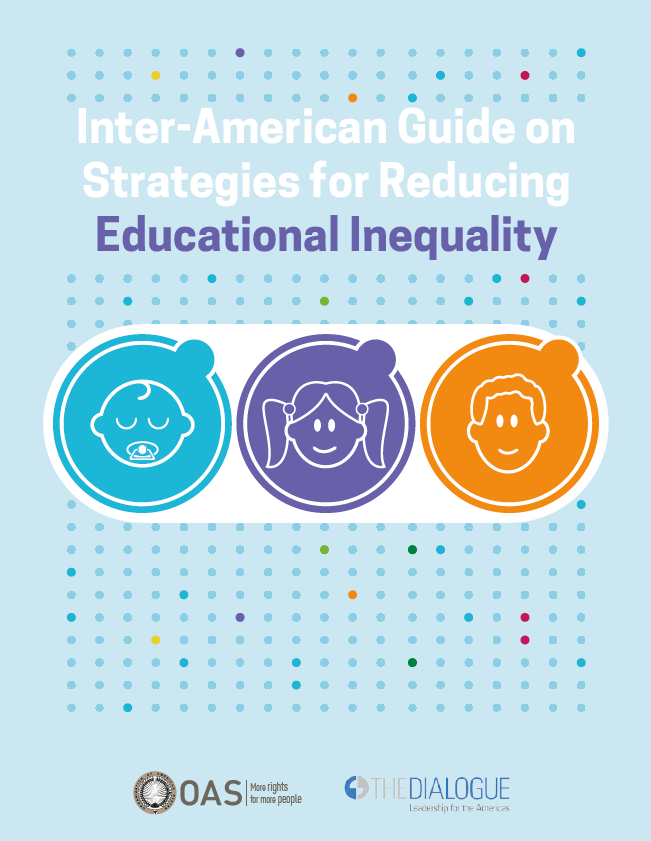Protecting Latin America’s Poor During Economic Crises
History tells us that economic crises cause large increases in poverty. The most recent economic crisis will cause Latin America’s GDP to contract around 2 percent in 2009.
This post is also available in: Español
Educational inequality is a critical issue in Latin America. While school enrollment rates have increased at all levels, children living in poverty or other marginalized groups still experience lower levels of enrollment, graduation and academic performance than their more well-off peers.
The Inter-American Guide on Strategies for Reducing Educational Inequality presents ten policy strategies that have proven effective at reducing educational inequality. The report, produced by the Organization of American States and the Inter-American Dialogue with support from CAF-Development Bank of Latin America, analyzes strategies that respond to the specific and diverse needs of different marginalized groups and provide them with high-quality education, which historically has been accessible only to their more privileged peers. For each policy strategy, we present evidence of its impact and effectiveness, offer examples from countries within and outside the region and analyze lessons learned from these policies.
We hope this document will serve as a practical tool that can guide countries in defining and revising their own policies and strategies. The document is framed within the United Nation’s Sustainable Development Goals, particularly Goal 4, which seeks to ensure a high-quality and equitable education for children in early childhood and in primary and secondary school.
1. Countries need to increase funding specifically aimed at reducing inequality: The scale of educational inequality in Latin America requires countries to dedicate greater resources to programs targeted specifically towards children living in poverty or in vulnerable conditions. This means that, in addition to financing universal education programs, the public sector must invest greater resources to curb educational inequality. A corollary of this approach may involve decentralizing program management to regional or departmental levels, where authorities have the local knowledge necessary to identify communities’ most pressing needs, select beneficiary schools and students, and oversee implementation. At the same time, countries must improve monitoring, evaluation and accountability systems to ensure the effective use of public funds.
2. Equity-focused strategies require a clearly defined target population and a diagnosis of their needs. Efficient allocation of public resources requires policymakers to be equipped with the skills and tools to identify the most disadvantaged children. To do so, countries must improve the design and use of targeting systems—instruments that are typically used by social protection systems to identify possible beneficiaries—which remain largely underutilized and often suffer from design flaws. Countries can also focus efforts on schools with the worst educational indicators – such as poor academic performance or high drop-out rates. For this, countries must improve the design and use of information management systems to inform decision-making.
3. These strategies also require greater inter-sectoral coordination: Educational inequality stems from a wide variety of factors, many of which fall outside the realm of public education—for instance, children’s physical and mental health as well as their home and community environment all play a role. Coordination between public ministries is crucial for holistically addressing the causes of educational inequality. This means that ministries must stop working in silos, and instead establish common goals and align their budgets and work plans accordingly.
4. All programs should be framed within a wider, explicit strategy for reducing educational inequality. These strategies must respond to each country’s realities, define goals and objectives, specify implementation and monitoring plans, and set budgets that guide the use of public funds. Effective strategies will also determine the roles that different departments and stakeholders must play and provide guidelines for inter-ministerial coordination.
History tells us that economic crises cause large increases in poverty. The most recent economic crisis will cause Latin America’s GDP to contract around 2 percent in 2009.
Since achieving independence in 1804 to become the world’s first free black state, Haiti has been beset by turbulent, often violent, politics and a gradual but seemingly unstoppable slide from austerity to poverty to misery.
Even before a massive earthquake transformed much of the capital city of Port-au-Prince into rubble, Haitians were already bound together by the shared trauma of collective memory.
